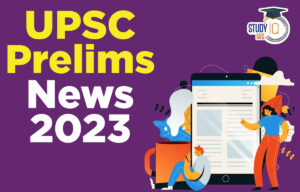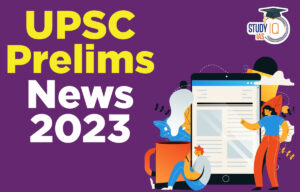UPSC Prelims News of 16 January 2023
Local Bubble
About
- The Local Bubble is a 1,000-light-year-wide cavity or a superbubble in an interstellar medium. Local bubble also exists in the Milky Way.
- The Local Bubble is not spherical, but seems to be narrower in the galactic plane, becoming elliptical, and may widen above and below the galactic plane, taking the shape of an hourglass.
- Formation: Local Bubble is thought to have originated from supernovae roughly 14 million years ago.
- Significance: Superbubbles trigger the formation of new stars and planets and influence the overall shapes of galaxies.
- Studies have shown that star-forming regions occur along the surface of bubbles due to accumulation of gases and debris.
- Despite their discovery, mechanisms powering the formation and expansion of local bubbles are not known. The role played by magnetic fields in their formation is also not known.
Exoplanets
Context: The National Aeronautics and Space Administration (NASA) has announced that the James Webb Space Telescope has discovered its first new exoplanet.
About Exoplanets
- Exoplanets are planets that orbit other stars and are beyond our solar system.
- Exoplanets come in a host of different sizes and are known to have different kinds of temperatures.
- Also, they are made up of elements similar to those of the planets in our solar system, but the mixture of those elements may differ.
- The new discovery: Researchers have labelled the recently discovered planet as LHS 475 b, and it’s roughly the same size as Earth.
- Located just 41 light-years away, the planet orbits very close to a red dwarf star and completes a full orbit in just two days.
- Significance: The study about exoplanets not only broadens our understanding of other solar systems, but also helps us piece together information about our own planetary system and origin.
- Discovering exoplanets is quite tough as they are small and hard to spot around their bright host stars. So, scientists rely on the transit method, which is “measuring the dimming of a star that happens to have a planet pass in front of it”.
- Need for Studying Exoplanets
- To find answers if we are alone in the Universe.
- To determine if a discovered world is habitable or not.
Hockey Blue Turf
About Blue Turf
- It was first introduced in the 2012 London Olympics, alongside a fluorescent yellow ball.
- Wet playing surface: Water reduces friction and improves the speed and consistency of the ball roll, allowing for smooth, fast play.
- Water provides shock absorption to put less strain on the players’ joints.
- Significance: Blue surface provides outstanding contrast against the yellow ball.
- It helps players spot and control the ball better.
- Excellent foot grip and fewer skin burns
- Uniform ball roll
- High ball accuracy and roll speed
- Lower friction in either wet or dry weather
- Fine shock-absorbing ability
- Tough and elastic fibres
- Boon for broadcasters: Contrast between the deep blue of the field and the yellow of the ball makes the game easier to follow, when compared with the traditional green surface and white ball.
- Develop Dedicated Viewership and Fandom: Improve fan interest by providing field hockey with one of the most unique playing surfaces in sports.
Asian Waterbird Census
Why in News? A survey conducted as part of the Asian Waterbird Census (AWC) 2023 has shown decrease in the populations of some migratory waterbirds.
About:
- The AWC is conducted in January each year and is coordinated by the Wetlands International South Asia and the Bombay Natural History Society in India.
- It is a citizen-science programme supporting conservation and management of wetlands and waterbirds worldwide.
- It is an integral part of the global waterbird monitoring programme, the International Waterbird Census (IWC), coordinated by Wetlands International.
- It runs in parallel with other regional programmes of the International Waterbird Census in Africa, Europe, West Asia, the Neotropics and the Caribbean.
- It was initiated in 1987 in the Indian subcontinent.
Maghi Mela
Why in News? Maghi Mela was recently celebrated in the city of Sri Muktsar Sahib in Punjab.
About:
- Maghi Mela is held every year in January, or on the month of Magh according to the Nanakshahi calendar.
- The Mela is celebrated in memory of 40 Sikh warriors who were killed fighting the Mughals in the Battle of Khidrana in 1705, which was named Muktsar after the battle.
- The bodies of the warriors were cremated the following day, the first of Magh (hence the name of the festival).
- Sikhs celebrate the Maghi with an end-to-end recital of the holy Guru Granth Sahib and religious rituals in all the Sikh Gurudwaras.
Womaniya Initiative
Why in News? A function was held recently to commemorate the success of “Womaniya on Government e-Marketplace (GeM)” at Constitution Club in New Delhi.
About:
- Womaniya Initiative was launched in 2019.
- It has sought to encourage the participation of women entrepreneurs and self-help groups (SHG) from the informal sector on the GeM portal and facilitate the sale of their products directly to various Government buyers, sans intermediaries.
- Products like handicrafts and handloom, accessories, jute and coir products, home décor and office furnishings are categorized for ease-in-procurement.
- The initiative will spur hyper-local procurement thereby integrating local value-chains through “Vocal for Local” and “Make in India” initiatives of the Government.
- The initiative aligns with Government’s initiatives for MSMEs, especially to reserve 3 percent in government procurement from women entrepreneurs.
Remote Voting
Why in News? Election Commission has invited all national parties for a meeting to discuss and demonstrate the Remote Voting Machine (RVMs).
About:
- Remote voting may take place in person somewhere other than an assigned polling station or at another time, or votes may be sent by post or cast by an appointed proxy.
- The remote voting location can be either abroad or from within the country.
- It comprises both electronic voting and non-electronic voting mechanisms.
Remote Voting Machine (RVMs)
- The RVMs are stand-alone, non-networked systems, effectively providing the voter the same experience as currently used EVMs.
- The unique feature of RVMs is that a single Remote Ballot Unit (RBU) will be able to cater to multiple constituencies (as many as 72) by using a dynamic ballot display board instead of the usual printed paper ballot sheet on EVMs.
Matsya 6000
Why in News? India will send three persons to six thousand metre below sea level for exploration of resources like minerals under Samudrayaan Mission.
About:
- ‘MATSYA 6000’ is an indigenously developed manned submersible vehicle.
- It is being designed and developed by National Institute of Ocean Technology (NIOT), Chennai under Ministry of Earth Sciences (MoES).
- It will facilitate the MoES in conducting deep ocean exploration of resources such as gas hydrates, polymetallic manganese nodules etc.
- It has an endurance of 12 hours under normal operation and 96 hours in case of emergency for human safety.
REWARD Project
Why in News? The World Bank has decided to get Sub-Saharan farm officials to Karnataka to learn from its REWARD Project.
About:
- Rejuvenating Watersheds for Agricultural Resilience through Innovative Development (REWARD) is a project which is being implemented in three-four Indian states.
- The Government of India, the State Governments of Karnataka and Odisha and the World Bank have signed a loan agreement for implementation of REWARD Project.
- Objective: The project aims to help national and state institutions adopt improved watershed management practices to help increase farmers’ resilience to climate change and promote higher productivity and better incomes.
- This project is a joint initiative of the Department of Land Resources, Ministry of Rural Development in association with the World Bank.


 UPSC Prelims News 17 March 2023
UPSC Prelims News 17 March 2023
 UPSC Prelims News 7 March 2023
UPSC Prelims News 7 March 2023
 UPSC Prelims News 1 March 2023
UPSC Prelims News 1 March 2023

























